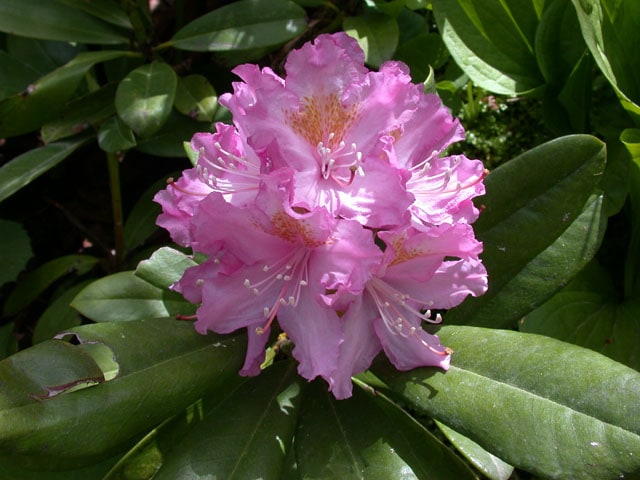Rhododendron x sochadzeae
Billeder af Rhododendron x sochadzeae
Beskrivelse
R. ponticum x R. caucasicum –> Rhododendron x sochadzeae Charadze & Davlianidze –har håret frugtknude–
Denne hybrid har hvidlige-lyspink blomster med bredere lober. Med glatte bladundersider.
Rhododendron x sochadzeae er sikkert en hybrid selvom den vokser noget isoleret og sætter mange frø, men det er ikke disse frø der giver den næste generation. De gamle eksemplarer der findes på Tiryal Dag (Dagi)(41.23333, 41.61667, 9.13, 5.68, 203°, SSW) 2700m (above Murgul) er alle 2N i kromosomantal. De undersøgte RFLP systemer viser heterozygoti på alle loci. Et eksempel på hybrid-vitalitet. Forældrearterne her er svagere end deres hybrid. Planten har svag pink blomsterfarve. Må være god som podeunderlag.
Milne et al. 1999 (pdf. HYBRIDIZATION AMONG SYMPATRIC SPECIES OF RHODODENDRON (ERICACEAE) IN TURKEY: MORPHOLOGICAL AND MOLECULAR EVIDENCE1
R. sochadzeae forms large populations in which neither segregation nor backcrossing occur, in habitats intermediate between those of its parents. Using single-copy species-specific random amplified polymorphic DNA and intersimple sequence repeat markers, it was determined that all R sochadzeae plants are F1s, and that there are many separate genets present. Through hand pollination experiments, it was determined that R. sochadzeae plants can produce viable F2 seeds or backcrosses in either direction. Therefore, all non-F1 hybrid derivatives appear to be eliminated at Tiryal Dag due to post-germination selection.
However, adult backcrosses can and do recruit in large numbers in different habitat conditions at another site. From this, the selection that favours F1s over BCs at Tiryal Dag must be habitat-mediated. We concluded that strong habitat-mediated selection is most likely to maintain species barriers at Tiryal Dag by eliminating hybrid generations subsequent to F1. Similar forces might occur in other hybrid zones, but may be countered by additional effects that increase fitness in post-F1s, or restrict the formation and / or fitness of F1s. We suggest that the superior fitness of the F1s might be due to gene complexes that confer tolerance of specific habitat conditions in each parent that break up after the F1 generation.





